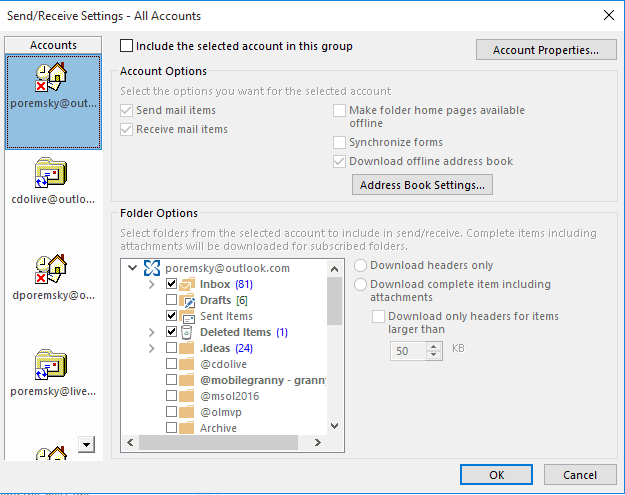Outlook 2016 Mac Manual Check Mail
Unless you change Outlook’s AutoArchive settings, Outlook does not archive your items automatically. Some businesses, however, might have it enabled for their users. Other companies might instead use an autodelete service to purge old messages, but check your company’s email retention policy before you make any changes to the AutoArchive settings.
If you have Outlook configured to check for new mail automatically but only want to send when you hit Send and Receive, press Ctrl+Alt+S to open the Send and Receive Settings dialog. Either disable automatic send and receives or click Edit then select the account and uncheck Send mail items (shown in the last screenshot). Outlook 2016 Quick Reference Card To Access the Inbox: Click the Mail button in the Navigation Bar. To Check for New Messages: Click the Send/Receive button on the Quick Access toolbar, or press F9. Message Indicators: Message has not been read. File is attached to the message. Message has high or low importance. Include this group in send/receive (F9) should be ticked in the When Outlook is Offline section at the bottom of the dialog. Check Schedule and automatic send/receive every nn minutes and select an appropriate time. It should be 5 - 8 minutes, minimum. Click Edit to edit the account settings. How to Archive Mail in Outlook 2016. Use the archive feature in Outlook 2016 to keep your mailbox from growing out of control. When you archive email, it saves the messages in another Outlook data file (.pst), which you can open at any time. Meanwhile, the Outlook file that you work with every day stays lean and mean.
If you want to turn on AutoArchive, see how Outlook is set up to archive your old items, or change the way Outlook does the job, follow these steps:
Select the File tab and click the Options button.
The Outlook Options dialog box opens.
Click the Advanced button in the Navigation pane on the left.
Clickfree c2 user manual for mac. Fill it upYou’re not some sicko who would let valuable hard drive space go unfilled, are you?Because this Clickfree C2 Desktop Backup Drive has 1 terabyte of space. That’s a lot of bytes!
The options for working with Outlook pages appear.
In the AutoArchive section, click the AutoArchive Settings button.
The AutoArchive dialog box opens.
Don’t go barging through the AutoArchive dialog box changing things willy-nilly — at least not until you look to see what’s already set up. Four important tidbits that the AutoArchive dialog box normally tells you are:
Whether the AutoArchive feature is turned on
How often Outlook archives items
Mac all terrain folding wagon manual pdf. How old items have to be for Outlook to send them to the archive
The name and location of the archive file
If you turn on AutoArchive without changing any of the other AutoArchive settings, Outlook automatically archives items every 14 days, sending items that are more than six months old to the archive file listed in the AutoArchive dialog box. For most people, those settings are just fine.

Some people prefer to turn off the AutoArchive feature and run the archive process manually. You can turn on or off the AutoArchive process by selecting or deselecting the Run AutoArchive Every check box at the top of the AutoArchive dialog box. You can also change how often AutoArchive runs by replacing the 14 in the text box with any number between 1 and 60.

Apple Mac Manual
If all you do is turn on AutoArchive and make no other changes here, you might be surprised to find out that your Inbox — as well as some other folders — will not be autoarchived. Each folder has its own AutoArchive settings, which can be different from other folders’ AutoArchive settings.
Outlook 2016 Mac Manual Check Mail Login
If you want to autoarchive all your folders with identical settings, make sure to also click the Apply These Settings to All Folders Now button in the AutoArchive dialog box — that is, all folders except for the Contacts folder, which can’t be archived. Autoarchiving all your folders might not be a great idea if you never clean out your Deleted Items or Junk Email folders — you’d wind up archiving lots of spam and deleted messages.